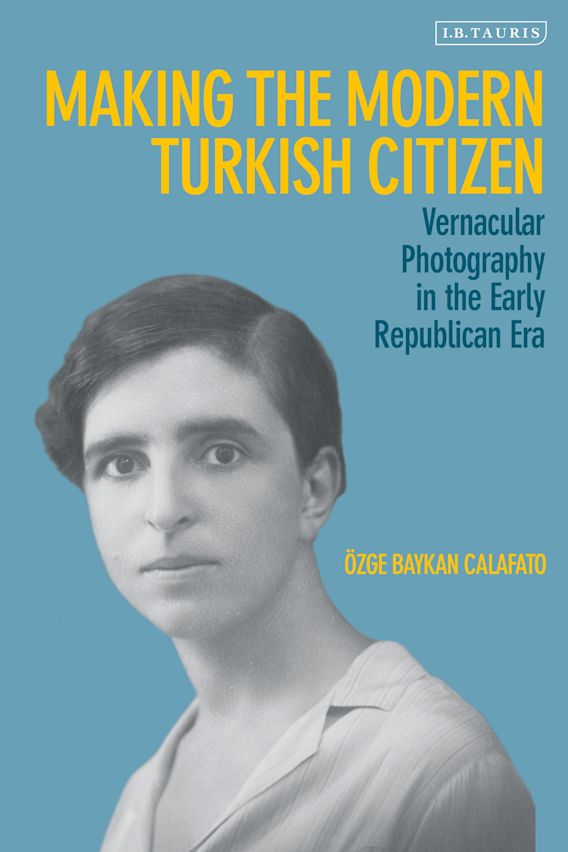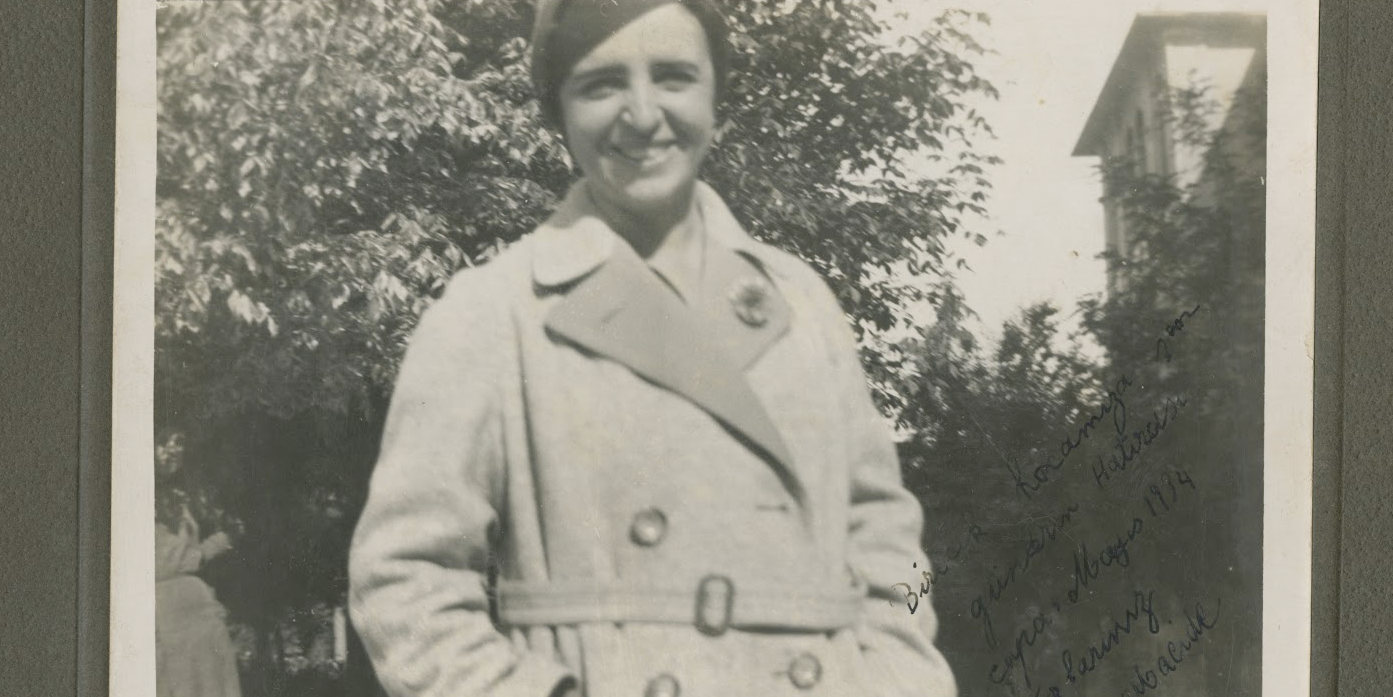Vernacular Photography in Early Republican Turkey
hosted by Zeinab Azarbadegan
| What can family and individual studio photographs tell us about social life in the early Republic of Turkey? In this episode, Özge Calafato highlights the negotiations between the Kemalist state, the photographers, and the people being photographed that led to classed and gendered representation of modern Turkish citizens in vernacular photography. Calafato analyzes not only the image, but also the context of production and the inscriptions written behind photographs. Looking at photos of subjects as ranging from beauty queens and feminist activists to bank employees and soldiers, she considers the production and circulation of photos not only in urban studios and within families but also in rural areas and within friendship groups.

 | Click for RSS Feed | 
|

|
What can family and individual studio photographs tell us about social life in the early Republic of Turkey? In this episode, Özge Calafato highlights the negotiations between the Kemalist state, the photographers, and the people being photographed that led to classed and gendered representation of modern Turkish citizens in vernacular photography. Calafato analyzes not only the image, but also the context of production and the inscriptions written behind photographs. Looking at photos of subjects as ranging from beauty queens and feminist activists to bank employees and soldiers, she considers the production and circulation of photos not only in urban studios and within families but also in rural areas and within friendship groups.
Stream via SoundCloud
Contributor Bios
 |
Özge Calafato is Lecturer in Literary and Cultural Analysis at the University of Amsterdam. Her research interests lie at the intersection of photography, archives, memory and cultural identity. She is the author of "Making the Modern Turkish Citizen: Vernacular Photography in the Early Republican Era" (I.B. Tauris, 2022). |
 |
Zeinab Azarbadegan is a British Academy Postdoctoral Fellow at the London School of Economics and Political Science (LSE). Her research focuses on the intersection of inter-imperial relations and history of science, technology, and medicine, in nineteenth century Ottoman Iraq |
Credits
Episode No. 532
Release Date: 11 October 2022
Audio editing by Zeinab Azarbadegan
Music: Seyyan Hanım - Gönlüm Sensiz Olmaz, İbrahim Özgür- Mavi Kelebek, Seyyan Hanım - Mazi
Images courtesy of Akkasah, the photography archive at al Mawrid, NYUAD. Copyright al Mawrid
Bibliography courtesy of Özge Calafato
Release Date: 11 October 2022
Audio editing by Zeinab Azarbadegan
Music: Seyyan Hanım - Gönlüm Sensiz Olmaz, İbrahim Özgür- Mavi Kelebek, Seyyan Hanım - Mazi
Images courtesy of Akkasah, the photography archive at al Mawrid, NYUAD. Copyright al Mawrid
Bibliography courtesy of Özge Calafato
Further Listening
 |
Özlem Gülin Dağoğlu | 378
9/13/18
|
Mihri Rasim Between Empire and Nation |
 |
Armen T. Marsoobian | 255
8/4/16
|
Armenian Photography in Ottoman Anatolia |
 |
Ahmet Ersoy | 309
3/30/17
|
Everyday Life and History in Ottoman Illustrated Journals |
 |
Zeynep Gürsel | 502
6/9/21
|
collaboration with AnthroPod
|
 |
Nazan Maksudyan | 205
10/25/15
|
Women and Suicide in Early Republican Turkey |
Images

 (recto and verso) A couple posing in a hall, 1941.
(recto and verso) A couple posing in a hall, 1941.
 Mustafa Kemal Atatürk dancing with his adoptive daughter Nebile at her wedding in Ankara Palas, February 27, 1929. Milliyet, Istanbul University Library.
Mustafa Kemal Atatürk dancing with his adoptive daughter Nebile at her wedding in Ankara Palas, February 27, 1929. Milliyet, Istanbul University Library.
) Naşide Saffet Hanım, Turkish beauty queen of 1931.
Naşide Saffet Hanım, Turkish beauty queen of 1931.
 A multigenerational family portrait, Hamza Rüstem Studio, circa 1920s.
A multigenerational family portrait, Hamza Rüstem Studio, circa 1920s.
 An aviation officer, 1935.
An aviation officer, 1935.

 Left: A negative print of a group at a picnic spot. Right: A positive print of the same photo, circa 1930s.
Left: A negative print of a group at a picnic spot. Right: A positive print of the same photo, circa 1930s.



Şükrü Bey Series. Left: "My precious Şükrü Bey! I know that months and years erase memories very fast! In order to save myself from the danger of being forgotten, I present my picture to you. March 1, 1927." Center: "To our valuable friend Şükrü Bey, hoping this picture strengthens the feelins of love and sincerity developed in the cold climate of Ankara. Ankara, February 25, 1927.[..] from Fatsa" Right: "To my brother Şükrü Bey, hoping that it reminds you of the valuable moments, Çorlu Ziraat Bank muavin, February 21, 1927."





 Nebahat Hâmit Karaorman, Various Studios (Photo Iris, Sébah and Joaillier, Jules Kanzler, Photo Français, Foto S. Süreyya), Istanbul, circa 1920s.
Nebahat Hâmit Karaorman, Various Studios (Photo Iris, Sébah and Joaillier, Jules Kanzler, Photo Français, Foto S. Süreyya), Istanbul, circa 1920s.
 Nebahat Hâmit Karaorman outside the Çapa Teachers’ School, May 1934.
Nebahat Hâmit Karaorman outside the Çapa Teachers’ School, May 1934.
Select Bibliography

Ak, Seyit Ali. Erken Cumhuriyet Dönemi Türk Fotoğrafı. Istanbul: Remzi Kitabevi, 2001.
Batchen, Geoffrey. Forget Me Not: Photography and Remembrance. Amsterdam and New York: Van Gogh Museum and Princeton Architectural Press, 2004.
Bölük, Gülderen. Fotoğrafın Serüveni. Istanbul: Kapı Yayınları, 2014. Bozdoğan, Sibel, and Reşat Kasaba, eds. Rethinking Modernity and National Identity in Turkey. Seattle: University of Washington Press, 1997.
Calafato, Özge. “A Wooden Box, Tripod and Cloth: The Role of Alaminüt Photography in the Making of Modern Turkey.” In The Camera as Actor: Photography and the Embodiment of Technology, edited by Amy Cox Hall, 57–77. London and New York: Routledge, 2021.
Çelik, Zeynep, and Eldem Edhem, eds. Camera Ottomana: Photography and Modernity in the Ottoman Empire 1840–1914. Istanbul: Koç University Press, 2015.
Derderian, Beth. “Portraits of Unbelonging: A Special Crossover Episode with Ottoman History Podcast.” AnthroPod, June 9, 2021.
Edwards, Elizabeth. “Photography and the Performance of History.” Kronos 27, no. 12 (2001): 15–29.
Eldem, Edhem. “The Search for an Ottoman Vernacular Photography.” In The Indigenous Lens? Early Photography in the Near and Midd le East, edited by Staci Gem Scheiwiller and Markus Ritter, 29–56. Berlin and Boston: De Gruyter, 2018.
Ersoy, Ahmet. “Ottomans and the Kodak Galaxy: Archiving Everyday Life and Historical Space in Ottoman Illustrated Journals.” History of Photography 40, no. 3 (2016): 330–57.
Micklewright, Nancy. “Late Ottoman Photography: Family, Home, and New Identities.” In Transitions in Domestic Consumption and Family Life in the Modern Midd le East: Houses in Motion, edited by Relli Schechter, 65–84. New York: Palgrave, 2003.
Özendes, Engin. Photography in The Ottoman Empire 1839–1923. Istanbul: YEM Yayınları, 2013.
Ryzova, Lucie. “The Image sans Orientalism.” Middle East Journal of Culture and Communication 8, no. 2 (2015a): 159–71.
Shaw, Wendy M. K. “The Ottoman in Ottoman Photography: Producing Identity through Its Negation.” In The Indigenous Lens? Early Photography in the Near and Middle East, edited by Staci Gem Scheiwiller and Markus Ritter, 173–92. Berlin and Boston: De Gruyter, 2018.
Tekeli, Şirin. “Emergence of the New Feminist Movement in Turkey.” In The New Women’s Movement, edited by Drude Dahlerup, 179–99. Beverly Hills: Sage Publications, 1986.
Yılmaz, Hale. Becoming Turkish: Nationalist Reforms and Cultural Negotiations in Early Republican Turkey (1923–1945). Syracuse, NY: Syracuse University Press, 2013.











Comments
Post a Comment
Due to an overwhelming amount of spam, we no longer read comments submitted to the blog.